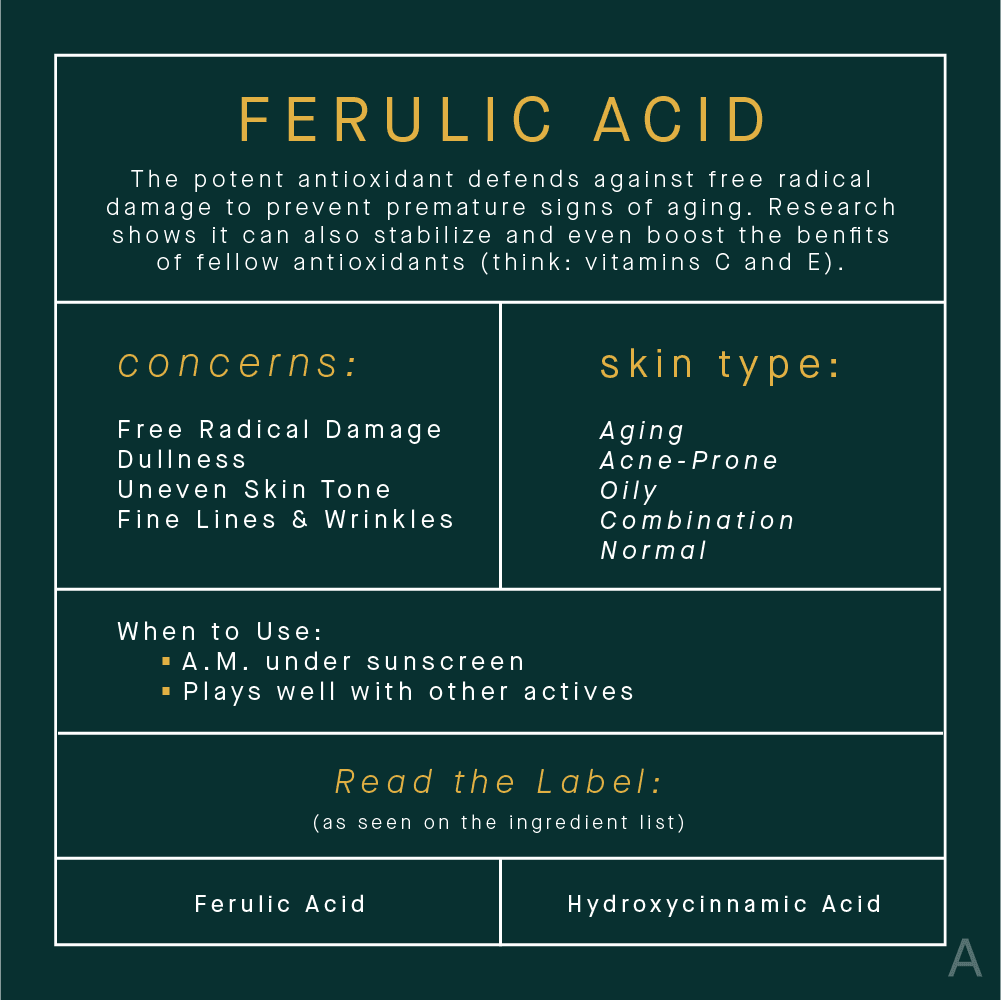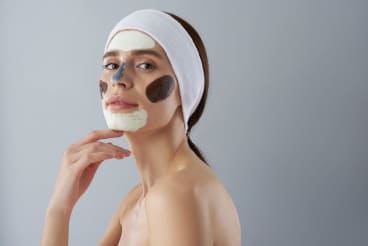 TCA Peel
TCA PeelRead The Label: All Your Ferulic Acid Questions Answered
When you think of antioxidants in skincare, you likely think of vitamins C or E. But what about ferulic acid? Here’s what you need to know about the potent free-radical fighter.
Feel like you need a dictionary every time you look at the ingredient list of a beauty product? Still unsure of the difference between retinol and retinoids? What about the unique benefits of vitamins B, C, and E? Are alpha and beta hydroxy acids the same thing? The skincare aisle can be overwhelming, but you don’t need a PhD in cosmetic chemistry to navigate it. With expert help, The AEDITION is demystifying and simplifying the beauty industry — one label at a time.
When you think of antioxidants in skincare, you likely think of vitamin C or vitamin E. But what about ferulic acid? Don’t let the term ‘acid’ confuse you — ferulic acid is a potent antioxidant that is touted for its ability to protect the skin from signs of aging like fine lines, wrinkles, and uneven skin tone. Wondering how to use this multitasking active or if it's a good match for your skin? Here, we're answering all of your questions about ferulic acid, and how to reap the most rewards from the hero ingredient.
What Is Ferulic Acid?
Ferulic acid (a.k.a. hydroxycinnamic acid) is a plant-based antioxidant. It is “an organic compound commonly found in plant cell walls,” says Robert Finney, MD, a New York City-based board certified dermatologist. Those botanicals include oats, brown rice, peanuts, oranges, and apples, though synthetic versions can be created in a lab. In addition to fighting free radical damage, research has shown ferulic acid can stabilize and even boost the benefits of fellow antioxidants (chiefly, vitamins C and E).
Benefits of Ferulic Acid in Skincare

If your skincare routine already contains antioxidants, you may be wondering if there is a need to add ferulic acid to the mix. The short answer is: yes. “Ferulic acid is a powerful antioxidant that has been studied and proven to help fight off free radical damage of skin cells that occurs from sun exposure, pollution, and high energy visible light from devices,” Dr. Finney explains. For the uninitiated, high energy visible (HEV) light is another term for blue light, and it’s emanating from your cell phones, tablets, computers, and more.
Defending the body from free radicals helps keep skin cells that produce collagen and elastin healthy, which, in turn, prevents premature signs of aging. As you probably know, those premature signs of aging include:
But that’s not all. Perhaps what makes ferulic acid so unique is its ability to enhance other ingredients in your skincare routine. “It has anti-inflammatory properties and also has a stabilizing effect when combined with other antioxidants, such as vitamins C and E,” explains Marisa Garshick, MD, a board certified dermatologist in NYC. Since vitamin C can best be described as ‘temperamental,’ this is an important trait. “Vitamin C is notorious for being unstable, so this combination is frequently seen in over-the-counter preparations,” she explains.
The Best Candidates for Ferulic Acid
Anyone concerned about preventing free radical damage and proactively treating visible signs of aging and sun damage can benefit from adding ferulic acid to their skincare routine. Like any antioxidant, ferulic acid may be irritating to those with sensitive skin. Patch testing your product on the wrist or under the chin prior to using should give you a sense of how your skin will tolerate it. “I always tell patients to listen to their skin and not change too many things at once,” Dr. Finney cautions. “It is smart to add one skincare product at a time and see how your skin reacts.”
Fortunately, there are a variety of formulas with ferulic acid on the market, so it shouldn’t be too hard to find one that works for your skin type. “For example, those with acne-prone skin may opt for a formulation that won’t clog pores or worsen breakouts,” Dr. Garshick says. “While those with sensitive skin should select a product that is free of fragrance or other possible irritants.”
Finding the Right Ferulic Acid Product
Speaking of finding the right product, you’ll most often find ferulic acid in serum form and paired with other antioxidants. There is perhaps no clearer example than in SkinCeuticals CE Ferulic — a favorite of dermatologists and editors alike thanks to its clinically proven ability to both protect and treat the skin. More recently, the brand introduced Silymarin CF, which is specifically formulated for oily and breakout-prone skin. “It is oil-free and has salicylic acid to help fight off acne, while still containing 15 percent L-ascorbic acid and 0.5 percent ferulic acid,” Dr. Finney says.
If free radical protection is your main goal, Dr. Garshick recommends the Drunk Elephant C-Firma Day Serum. “It includes a combination of vitamin C, E, and ferulic acid, as well as fruit nutrients and extracts, to help protect the skin against free-radical damage while also firming and brightening the skin,” she explains.
Regardless of what product you choose, pay attention to the packaging. Ferulic acid should come in a dark or opaque bottle to protect it from light. Even better if it comes in an air-tight pump, as that will prevent oxidation from air. Once you bring it home, be sure to store it in a cool, dry place (i.e. not your steamy bathroom), and pay attention to the color. If the formula turns brown over time that may be an indication that it has oxidized and, therefore, lost some of its effectiveness.
How to Add Ferulic Acid into Your Skincare Routine
To enjoy the maximum benefits of ferulic acid, use it as part of your A.M. skincare routine. “While it is often paired with other ingredients, its use in a skincare routine depends on the formulation of the specific product,” Dr. Garshick explains. For example, if the ferulic acid is in serum form, apply it after cleansing but before your day cream and sunscreen. “That said, there are some moisturizing products that may contain [ferulic acid], in which case it would be fine to use when you apply your moisturizer,” she adds. By using it with sunscreen during daylight hours, Dr. Garshick says ferulic acid gives your skin an extra boost by “neutralizing any free radicals generated from exposures such as UV radiation or pollution.”
The Takeaway
Ferulic acid is a potent and proven antioxidant that protects the skin from environmental aggressors and, in turn, prevents signs of aging. To enjoy the benefits, add it to your morning routine and always pair it with a broad-spectrum sunscreen — no excuses.
All products featured are independently selected by our editors, however, AEDIT may receive a commission on items purchased through our links.
More Related Articles
Related Procedures

AI Plastic Surgeon™
powered by'Try on' aesthetic procedures and instantly visualize possible results with The AI Plastic Surgeon, our patented 3D aesthetic simulator.

